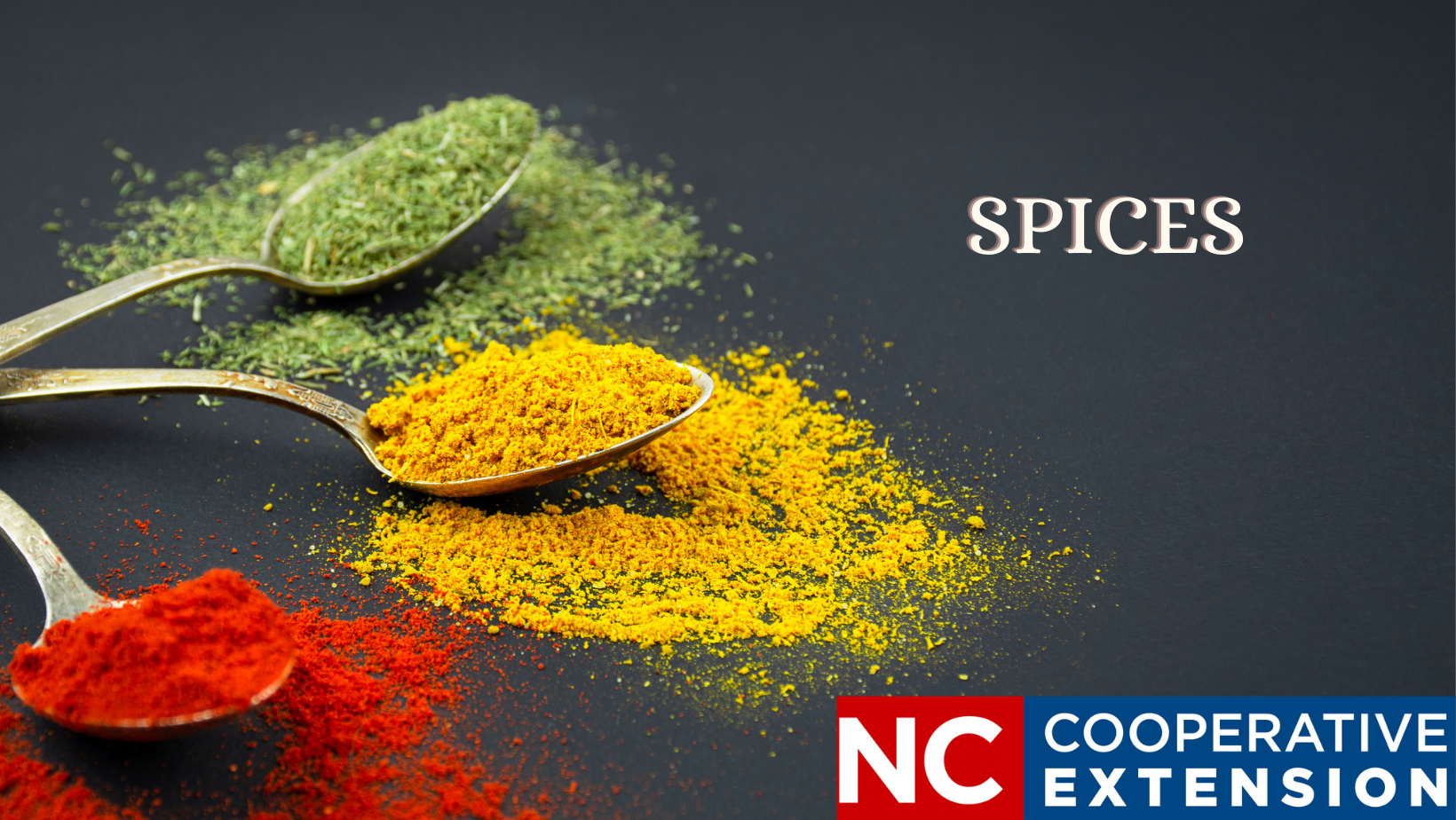Getting Ahead of the Holiday Meal Cost Part 4- Spices
go.ncsu.edu/readext?833003
en Español / em Português
El inglés es el idioma de control de esta página. En la medida en que haya algún conflicto entre la traducción al inglés y la traducción, el inglés prevalece.
Al hacer clic en el enlace de traducción se activa un servicio de traducción gratuito para convertir la página al español. Al igual que con cualquier traducción por Internet, la conversión no es sensible al contexto y puede que no traduzca el texto en su significado original. NC State Extension no garantiza la exactitud del texto traducido. Por favor, tenga en cuenta que algunas aplicaciones y/o servicios pueden no funcionar como se espera cuando se traducen.
Português
Inglês é o idioma de controle desta página. Na medida que haja algum conflito entre o texto original em Inglês e a tradução, o Inglês prevalece.
Ao clicar no link de tradução, um serviço gratuito de tradução será ativado para converter a página para o Português. Como em qualquer tradução pela internet, a conversão não é sensivel ao contexto e pode não ocorrer a tradução para o significado orginal. O serviço de Extensão da Carolina do Norte (NC State Extension) não garante a exatidão do texto traduzido. Por favor, observe que algumas funções ou serviços podem não funcionar como esperado após a tradução.
English
English is the controlling language of this page. To the extent there is any conflict between the English text and the translation, English controls.
Clicking on the translation link activates a free translation service to convert the page to Spanish. As with any Internet translation, the conversion is not context-sensitive and may not translate the text to its original meaning. NC State Extension does not guarantee the accuracy of the translated text. Please note that some applications and/or services may not function as expected when translated.
Collapse ▲
Now that canned goods and dry ingredients (Part 3) are taken care of, we are moving on to the ingredients known to add flavor and distinction to your dish, spices! With so many spices to choose from, remember this rule of thumb, take inventory so you don’t overspend. Certain recipes will call for a small amount of a certain spice, which is not commonly used. To save money, utilize something similar that you already have on hand. Certain spices such as basil & thyme; and red pepper & paprika can be used to substitute each other. If using a substitution, be advised that the recipe may be slightly altered. Depending on the amount of each spice you’ll be using, purchase small or large bottles and split with family or friends. Not only will this make sure the item will be used at its freshest, but you’ll also save money by splitting the cost! Herbs and spices from your garden will flavor any meal perfectly.
Here you will see some of the most common/popular holiday spices include:
| Baking Spices | Cooking Spices | Flavors, etc. |
|
Cinnamon |
Chili Powder |
Almond Extract |
| Ginger | Cumin | Lemon Extract |
| Nutmeg | Garlic & Onion Powder | Vanilla Extract |
| Peppermint | Kosher Salt | Lipton Onion Soup |
| Pumpkin Spice | Mint | Chicken Bouillon |
| Vanilla Bean Sugar | Paprika | Beef Bouillon |
| Bay Leaves | Rosemary | Rum Extract |
| Sage |
Tips: Organize your spices in the pantry by grouping them by purpose. A small basket or mason jars can be helpful; place the baking spices together in one basket and cooking spices in another. If you are baking, you can quickly find the spices you need without sorting through savory spices. Don’t forget your pantry staples: pepper, salt, season salt, garlic powder, Italian seasoning, poultry seasoning, and onion powder. All seasonings, herbs, and spices are SNAP-eligible items. Be sure to write down staple seasonings in your home and include them on your list. If a recipe calls for a specific salt such as Kosher salt, sea salt, or pink Himalayan salt, generally refined salt (table salt) will serve as an acceptable substitute. Why plan ahead for your spice purchases? Think about pumpkin pie without the pumpkin spice or dressing without sage.
As the holiday nears, more people will begin to stock up on their favorite spices – which guess what – they are your favorite spices too! Waiting until the last minute might mean that your trip to the grocery store for cinnamon leaves you empty handed and your batch of oatmeal cookies flat. Purchasing spices early will help spread out the cost of the holiday meal.
The Getting Ahead of Holiday Meal Cost series is sponsored by the More In My Basket (MIMB) Program. Visit their website for the complete series or to contact the More In My Basket staff.
More In My Basket (MIMB) will continue our series on planned shopping to spread out the cost of the holiday meal. Happy Shopping!
For more information please contact Sheila Gregory at sheila_gregory@ncsu.edu or via phone at 252-232-2261. The “Getting Ahead of Holiday Meal Cost” series is sponsored by the More In My Basket (MIMB) Program.




